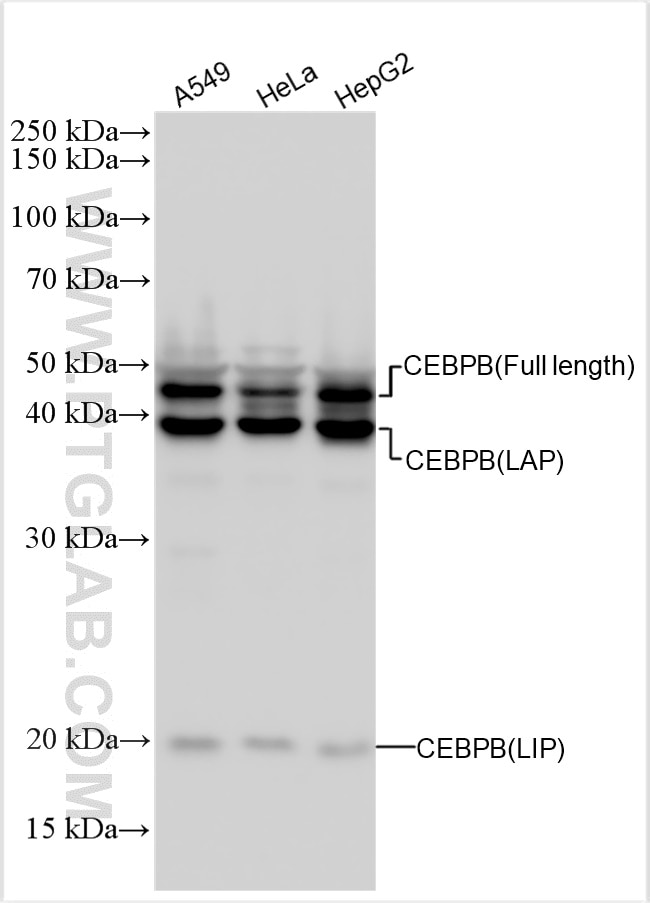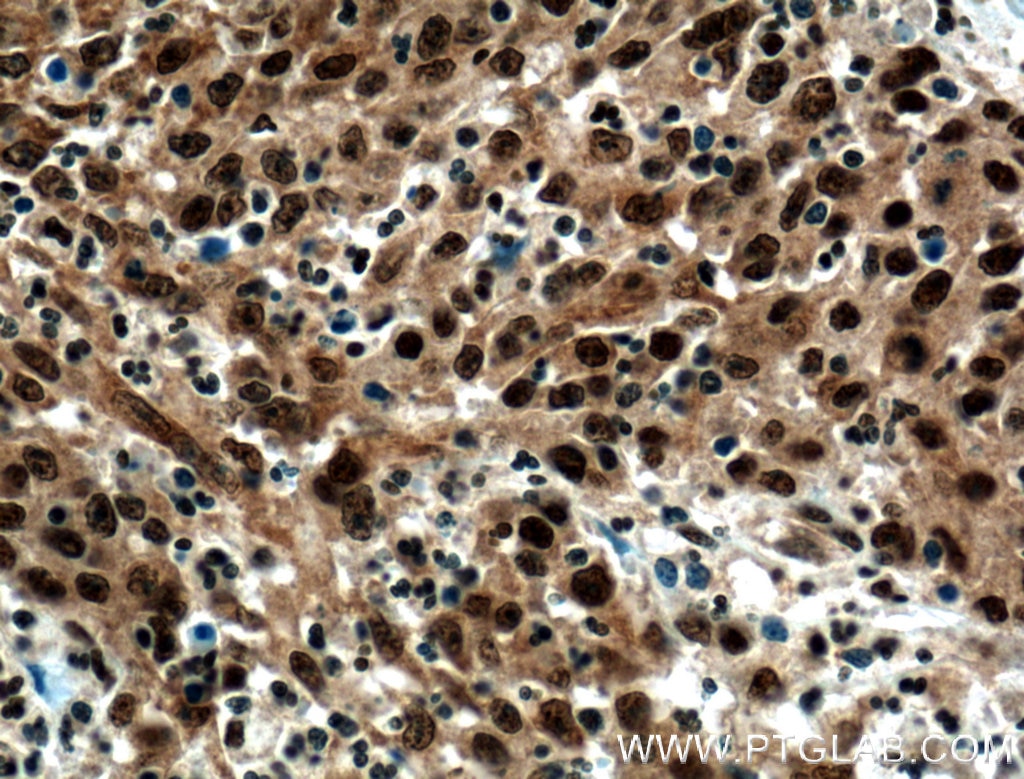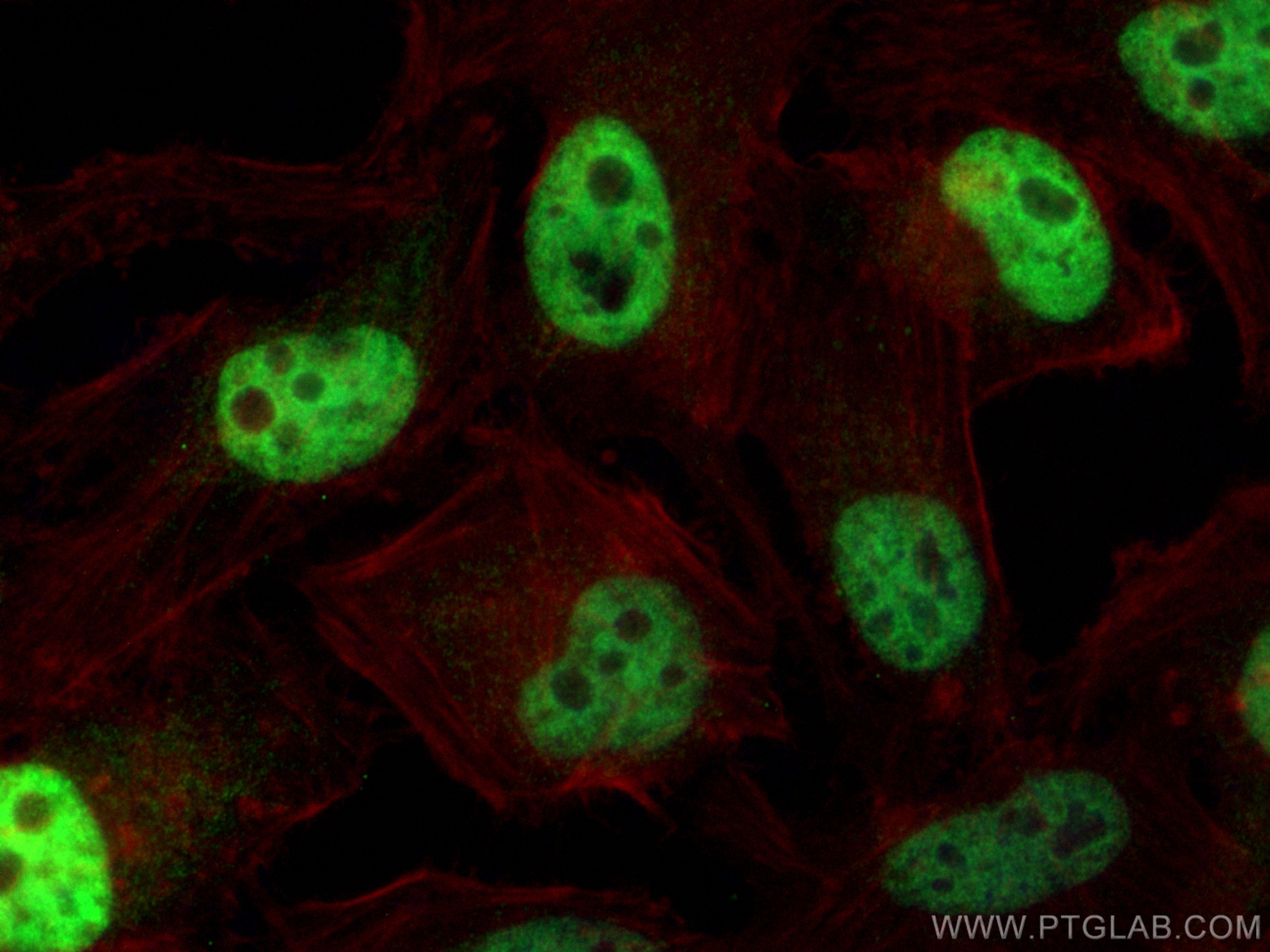- Phare
- Validé par KD/KO
Anticorps Polyclonal de lapin anti-CEBPB
CEBPB Polyclonal Antibody for WB, IF, IHC, ELISA
Hôte / Isotype
Lapin / IgG
Réactivité testée
Humain, souris et plus (1)
Applications
WB, IHC, IF/ICC, CoIP, ChIP, RIP, ELISA
Conjugaison
Non conjugué
N° de cat : 23431-1-AP
Synonymes
Galerie de données de validation
Applications testées
| Résultats positifs en WB | cellules A549, cellules HeLa, cellules HepG2 |
| Résultats positifs en IHC | tissu de cancer du côlon humain, il est suggéré de démasquer l'antigène avec un tampon de TE buffer pH 9.0; (*) À défaut, 'le démasquage de l'antigène peut être 'effectué avec un tampon citrate pH 6,0. |
| Résultats positifs en IF/ICC | cellules HeLa, |
Dilution recommandée
| Application | Dilution |
|---|---|
| Western Blot (WB) | WB : 1:5000-1:50000 |
| Immunohistochimie (IHC) | IHC : 1:50-1:500 |
| Immunofluorescence (IF)/ICC | IF/ICC : 1:200-1:800 |
| It is recommended that this reagent should be titrated in each testing system to obtain optimal results. | |
| Sample-dependent, check data in validation data gallery | |
Applications publiées
| KD/KO | See 4 publications below |
| WB | See 25 publications below |
| IHC | See 3 publications below |
| IF | See 3 publications below |
| CoIP | See 3 publications below |
| ChIP | See 6 publications below |
| RIP | See 1 publications below |
Informations sur le produit
23431-1-AP cible CEBPB dans les applications de WB, IHC, IF/ICC, CoIP, ChIP, RIP, ELISA et montre une réactivité avec des échantillons Humain, souris
| Réactivité | Humain, souris |
| Réactivité citée | rat, Humain, souris |
| Hôte / Isotype | Lapin / IgG |
| Clonalité | Polyclonal |
| Type | Anticorps |
| Immunogène | CEBPB Protéine recombinante Ag20073 |
| Nom complet | CCAAT/enhancer binding protein (C/EBP), beta |
| Masse moléculaire calculée | 345 aa, 36 kDa |
| Poids moléculaire observé | 42 kDa,46 kDa |
| Numéro d’acquisition GenBank | BC007538 |
| Symbole du gène | CEBPB |
| Identification du gène (NCBI) | 1051 |
| Conjugaison | Non conjugué |
| Forme | Liquide |
| Méthode de purification | Purification par affinité contre l'antigène |
| Tampon de stockage | PBS avec azoture de sodium à 0,02 % et glycérol à 50 % pH 7,3 |
| Conditions de stockage | Stocker à -20°C. Stable pendant un an après l'expédition. L'aliquotage n'est pas nécessaire pour le stockage à -20oC Les 20ul contiennent 0,1% de BSA. |
Informations générales
CCAAT/enhancer-binding protein beta (CEBPB), also known as LAP, is a important transcriptional activator in the regulation of genes involved in immune and inflammatory responses. It specifically binds to an IL-1 response element in the IL-6 gene. CEBPb mRNAs possess alternative translation-initiation codons, which result in the formation of truncated forms of the protein.Three variants of CEBPBs have been detected: a 46 kDa full-length liver-enriched transcription-activating protein (LAP1), a 42 kDa LAP2 and a 20 kDa liver-enriched transcription-inhibitory protein (LIP). (PMID:18820298). This antibody is specific to CEBPB.
Protocole
| Product Specific Protocols | |
|---|---|
| WB protocol for CEBPB antibody 23431-1-AP | Download protocol |
| IHC protocol for CEBPB antibody 23431-1-AP | Download protocol |
| IF protocol for CEBPB antibody 23431-1-AP | Download protocol |
| Standard Protocols | |
|---|---|
| Click here to view our Standard Protocols |
Publications
| Species | Application | Title |
|---|---|---|
Adv Sci (Weinh) HIPK1 Inhibition Protects against Pathological Cardiac Hypertrophy by Inhibiting the CREB-C/EBPβ Axis | ||
J Immunother Cancer YY1 complex in M2 macrophage promotes prostate cancer progression by upregulating IL-6 | ||
Aging (Albany NY) Functional rare variant in a C/EBP beta binding site in NINJ2 gene increases the risk of coronary artery disease.
| ||
Int J Mol Sci ERK1/2-CEBPB Axis-Regulated hBD1 Enhances Anti-Tuberculosis Capacity in Alveolar Type II Epithelial Cells | ||
Am J Physiol Cell Physiol The paracrine isthmin1 transcriptionally regulated by C/EBPβ exacerbates pulmonary vascular leakage in murine sepsis | ||
Sci Rep Identification of a 5-Methylcytosine Site that may Regulate C/EBPβ Binding and Determine Tissue-Specific Expression of the BPI Gene in Piglets. |




